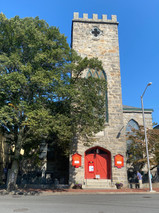Salem - The Witch Trials!
- Shelley Harris
- Nov 18, 2024
- 4 min read
I always wanted to go to Salem, Massachusetts, not for the Hocus Pocus stuff (although we did see a lot of Hocus Pocus filming locations), but to learn about the Salem Witch Trials, the true story.
We arrived at Winter Island Park campground on September 6. Winter Island has played an essential role in Salem’s defence for centuries. In 1643, fearing attacks from the Dutch, Salem began to construct a fort. In 1655, it was fortified with “big guns”. They added “great artillery” in 1673 and named it Fort William after the King. In 1704, the fort became Fort Ann after the Queen. During the Revolutionary War, the fort protected Salem privateers when they returned with British “prizes” (captured vessels). After the war, officials renamed the fort in honour of Salem’s Timothy Pickering, Secretary of State under President Washington. The fort was utilized during the Civil and Spanish-American Wars; Winter Island itself was the site of a Civil war camp for the Andrew Light Guard. It was also home to the US Coast Guard Air Training Station, built in 1944 during World War II. The Coast Guard Air Training Station closed in 1970 and Winter Island was reverted to the City on condition that it remain a public park or other public use. It was a beautiful and very interesting place to stay. The actual camping area was virtually the parking lot at the marina, so as you can imagine our views were pretty spectacular!
We are advocates for the hop on hop off trolley tours. Such a great way to get an overview and a lay of the land in any area.
Salem is such a beautiful town, and if you were into ghosts, witchcraft, haunted houses, goblins, etc., which we’re not, you would absolutely love it. Quite honestly, most of the history was quite disturbing to us…and not only the witch trials!
For example, Saint Peter’s Episcopal church, which was founded in 1733, and is still holding Sunday services today, wanted to add a chapel to the rear of the building in 1872; however, there was a graveyard in that area so in order to accommodate the extension of the building gravestones were moved to the front of the church and construction of the chapel commenced over the graveyard.
Same thing in the 1980s!! During our trolly tour we learned more disturbing history. The last almshouse built in Salem was in1816. Due to overcrowding an additional building was built on the same property in 1884 to serve as a hospital for contagious diseases. This site was active for over a century and burials are often referenced in City documents. The cemetery served as the only option for patients who could not afford a funeral and had no family to claim their remains. Despite being a site of a cemetery, the almshouse was destroyed in 1954, and the hospital was destroyed in the 1980s to make way for a condominium complex. We were told that after construction of the chapel over the graveyard at the church, a bylaw was passed not allowing construction to take place on top of graves that is less than six feet deep. During construction on this particular condo, at least five headstones were reportedly uncovered. To get around that, companies would pile enough dirt on top of the graves so they could legally build. The complex we were shown was high on a hill. I wonder if the people living there know. Ironically, the City of Salem commenced a historic preservation project of cemeteries in August 2023.
We did take a day just to walk around and take in the energy of Salem. It was a fun day. Cannot imagine of the energy of this place on Halloween!!
According to Visitor’s Information, despite all the museums, walking tours, local re-enactments, there was really only one place to get the full and truthful story about the Salem Witch Trials and that was the self-guided audio tour at the Peabody Essex Museum. We were there for 3 hours, and could have stayed much longer; however, it was quite overwhelming. Here’s the gist:
In 1688 Samuel Parris accepted a position as a puritan minister in Salem Village. It is told that the Minister created a climate of fear and paranoia and frequently preached about the workings of the devil, or witchcraft, which some say may have instigated the events leading to the Witch Trials. In January,1692 several young girls, including the daughter and niece of the Minister, started acting erratically and violently and claimed to be possessed by the devil and accused several local women of witchcraft. By February arrest warrants were issued for the 3 women accused. Before the year was over, more than 185 people were accused of practising witchcraft in Salem. The Minister eventually was pushed out the community for his role in this terrible time.
Twenty of the 185 accuseds were executed, most by hanging. One man was pressed to death under heavy stones, the only such state-sanctioned execution of its kind. Dozens suffered under inhumane conditions as they waited in jail for months without trials; many of the imprisoned were also tortured, and at least one died in jail.
The main evidence for these executions: “spectral evidence”, which is testimony from witnesses claiming to see the spirit of an accused tormenting them in their dreams or visions, believing that the devil could send specters to harm people, as was the Minister’s teachings.
As part of a walking tour we visited the memorial to the victims.
The hysteria finally abated in1693. And by 1702, the trials were declared as unlawful. In 1711 many of the convicted and executed were exonerated. It wasn’t until 1957 that the State of Massachusetts issued a formal apology. Several later rounds of exonerations, occurring over hundreds of years, attempted to complete this process for all victims. Efforts to serve justice continue even today: Massachusetts exonerated Elizabeth Johnson Jr. of Andover through legislative action in 2022.
In the years following the trials and executions, some involved, like judge Samuel Sewall and accuser Ann Putnam, publicly confessed error and guilt. Judge John Hathorne, on the other hand, never apologized for his role as a judge on the Court of Oyer and Terminer. His descendants were so ashamed of him that his great-great grandson, the writer Nathaniel Hawthorne, added the “w” to his name to distance himself from the family legacy.
We’re really glad we went to Salem. We learned a lot! If you'd like to see more pics, click here!



















































































Comments